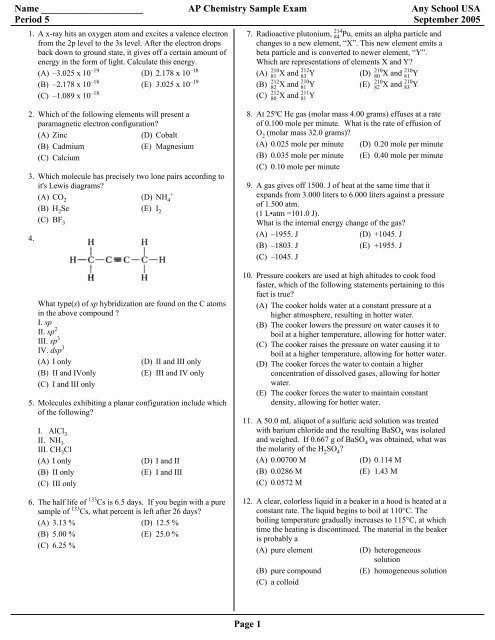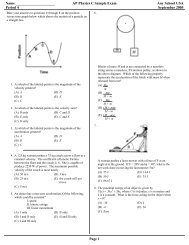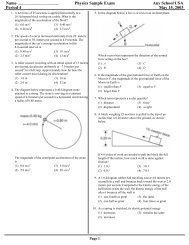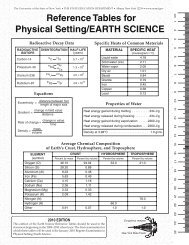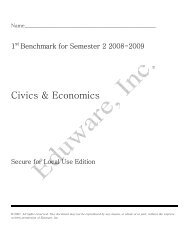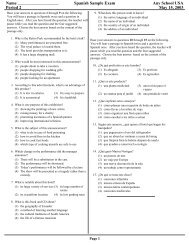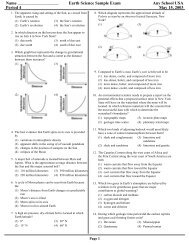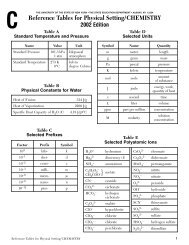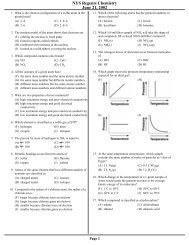Create successful ePaper yourself
Turn your PDF publications into a flip-book with our unique Google optimized e-Paper software.
Name _____________________ AP Chemistry Sample Exam Any School USAPeriod 5 September 20051. A x-ray hits an oxygen atom and excites a valence electronfrom the 2p level to the 3s level. After the electron dropsback down to ground state, it gives off a certain amount ofenergy in the form of light. Calculate this energy.(A) –3.025 x 10 –19 (D) 2.178 x 10 –18(B) –2.178 x 10 –18 (E) 3.025 x 10 –19(C) –1.089 x 10 –187. Radioactive plutonium, 21484Pu, emits an alpha particle andchanges to a new element, “X”. This new element emits abeta particle and is converted to newer element, “Y”.Which are representations of elements X and Y?(A) 210 212210 21081X and83Y (D) 80X and81 Y(B) 212 210210 21082X and81Y (E) 82X and83 Y211X and(C) 2128081 Y2. Which of the following elements will present aparamagnetic electron configuration?(A) Zinc(D) Cobalt(B) Cadmium(E) Magnesium(C) Calcium3. Which molecule has precisely two lone pairs according toit's Lewis diagrams?(A) CO 2(D) NH 4+(B) H 2Se (E) I 2(C) BF 34.What type(s) of sp hybridization are found on the C atomsin the above compound ?I. spII. sp 2III. sp 3IV. dsp 3(A) I only(D) II and III only(B) II and IVonly(E) III and IV only(C) I and III only5. Molecules exhibiting a planar configuration include whichof the following?I. AlCl 3II. NH 3III. CH 3Cl(A) I only(B) II only(C) III only(D) I and II(E) I and III6. <strong>The</strong> half life of 133 Cs is 6.5 days. If you begin with a puresample of 133 Cs, what percent is left after 26 days?(A) 3.13 % (D) 12.5 %(B) 5.00 % (E) 25.0 %(C) 6.25 %8. At 25ºC He gas (molar mass 4.00 grams) effuses at a rateof 0.100 mole per minute. What is the rate of effusion ofO 2(molar mass 32.0 grams)?(A) 0.025 mole per minute (D) 0.20 mole per minute(B) 0.035 mole per minute (E) 0.40 mole per minute(C) 0.10 mole per minute9. A gas gives off 1500. J of heat at the same time that itexpands from 3.000 liters to 6.000 liters against a pressureof 1.500 atm.(1 L•atm =101.0 J).What is the internal energy change of the gas?(A) –1955. J(D) +1045. J(B) –1803. J(E) +1955. J(C) –1045. J10. Pressure cookers are used at high altitudes to cook foodfaster, which of the following statements pertaining to thisfact is true?(A) <strong>The</strong> cooker holds water at a constant pressure at ahigher atmosphere, resulting in hotter water.(B) <strong>The</strong> cooker lowers the pressure on water causes it toboil at a higher temperature, allowing for hotter water.(C) <strong>The</strong> cooker raises the pressure on water causing it toboil at a higher temperature, allowing for hotter water.(D) <strong>The</strong> cooker forces the water to contain a higherconcentration of dissolved gases, allowing for hotterwater.(E) <strong>The</strong> cooker forces the water to maintain constantdensity, allowing for hotter water.11. A 50.0 mL aliquot of a sulfuric acid solution was treatedwith barium chloride and the resulting BaSO 4was isolatedand weighed. If 0.667 g of BaSO 4was obtained, what wasthe molarity of the H 2SO 4?(A) 0.00700 M(D) 0.114 M(B) 0.0286 M(E) 1.43 M(C) 0.0572 M12. A clear, colorless liquid in a beaker in a hood is heated at aconstant rate. <strong>The</strong> liquid begins to boil at 110°C. <strong>The</strong>boiling temperature gradually increases to 115°C, at whichtime the heating is discontinued. <strong>The</strong> material in the beakeris probably a(A) pure element(D) heterogeneoussolution(B) pure compound (E) homogeneous solution(C) a colloidPage 1
AP Chemistry Sample Exam13.What phase change is occuring from point A to point B?(A) Solidification (B) Condensation (C) Sublimation (D) Vaporization (E) Melting14.17. Which represents an acid-base reaction according to theLewis definition but not the Bronsted-Lowry definition?(A) MgCl 2(s) ↔ Mg 2+ (aq) + 2Cl – (aq)(B) CN – (aq) + H 2O(l) ↔ HCN(aq) + OH – (aq)(C) NH 3(g) + HBr(g) ↔ NH 4Br(s)(D) Fe(H 2O) 6 3+ (aq) + H 2O(l) ↔ [Fe(H 2O) 5OH] 2+ (aq) + H 3O + (aq)(E) HF(aq) + OH – (aq) → H 2O(l) + F – (aq)Look at the heating curve for a pure substance above.Which of the following is true about the substance frompoint D to E?(A) Kinetic energy is increasing; potential energy isdecreasing(B) Kinetic energy is decreasing; potential energy isincreasing(C) Kinetic energy is constant; potential energy isdecreasing(D) Kinetic energy is constant; potential energy isincreasing(E) Kinetic energy is increasing; potential energy isconstant18.A water solution of ions is prepared. Based on the Kavalues above, which ions will react with the water toproduce an acid solution at room temperature?15. <strong>The</strong> weight of HNO 3(molecular weight 63.0) in 40.0milliliters of 5.00-molar solution is(A) 5.6 g(D) 12.6 g(B) 8.7 g(E) 13.1 g(C) 10.4 g16. Which of the following is the weakest acid?(A) HClO 3(D) HClO 2(B) HClO 4(E) HClO(C) HClI. Na +II. Fe 3++III. NH 4–IV. HCO 3–V. HSO 4(A) I and II only(B) II and III only(C) I, II, and III only(D) II, III, and V only(E) III, IV, and V onlyPage 2
19. Consider the following:I. PO 43–II. HPO 42–III. H 2PO 4–IV. H 3PO 4<strong>The</strong> term amphiprotic can be used to describe(A) I only(D) II, III and IV only(B) I and II only(E) II and III only(C) I, II and III only20. Which curve best represents the titration of NaOH withHCl?(A)(C)AP Chemistry Sample Exam24. A student mixes 100. mL of 1.00 M calcium hydroxide(aq) with 100. mL of 1.00 M aluminum nitrate (aq).Assuming the hydroxide ion concentration becomesrelatively small, which of the following is true about theincreasing concentration of the remaining ions?(A) [Ca 2+ ] < [NO 3 – ] < [Al 3+ ] (D) [Ca 2+ ] < [Al 3+ ] < [NO 3– ](B) [Al 3+ ] < [NO – 3] < [Ca 2+ ] (E) [Al 3+ ] < [Ca 2+ ] < [NO – 3](C) [NO – 3] < [Al 3+ ] < [Ca 2+ ]25. __CuOH + __O 2+ __H 2O → __Cu(OH) 2If 2 moles of O 2oxidizes CuOH according to theunbalanced equation above, how many moles of Cu(OH) 2can be formed?(A) 2 (D) 6(B) 4 (E) 8(C) 5(B)(D)21. A container is filled with 10.0 L of 0.050 M NaI. What isthe maximum mass of solid Pb(NO 3) 2that can be dissolvedwithout forming a precipitate?(A) 1.1 × 10 –2 g(D) 5.6 × 10 –5 g(B) 2.2 × 10 –3 g(E) 5.6 × 10 –7 g(C) 3.2 × 10 –4 g22. K sp= 7.00 × 10 –9 for BaCO 3K sp= 9.90 × 10 –9 for CaCO 3A 100. mL solution is 0.10 M with respect to Ca(NO 3) 2and0.10 M with respect to Ba(NO 3) 2. If 0.10 M K 2CO 3isadded to the solution in drops until a precipitation occurs,which of the following will occur?(A) Barium carbonate will be the only precipitate.(B) Calcium carbonate will be the only precipitate.(C) Both calcium and barium carbonate will precipitate.(D) Potassium nitrate and barium carbonate willprecipitate.(E) Potassium nitrate and calcium carbonate willprecipitate.23. Mn 2+ + IO 3 – + H 2O → MnO 4 – + ½I 2+ 2H +What is the reducing agent in the reaction above?–(A) IO 3(D) H +(B) H 2O (E) I 2(C) Mn 2+26. As 2O 3+ 2NO 3 – + 2H 2O + 2H + → 2H 3AsO 4+ N 2O 3In this reaction, nitrogen(A) loses electrons and increases in oxidation number(B) gains electrons and increases in oxidation number(C) loses electrons and decreases in oxidation number(D) gains electrons and decreases in oxidation number(E) maintains the number of electrons and the oxidationnumber27. During the electrolysis of a solution of KCl, whatsubstance is produced at the anode?(A) H 2O(l)(D) H 2(g)(B) Cl 2(g)(E) K(s)(C) O 2(g)28. How long would it take, running a current of 9.65 amperes,to deposit 130. g of zinc from a solution of ZnF 2?(A) 4.00 × 10 4 s(D) 4.00 × 10 3 s(B) 2.00 × 10 4 s(E) 2.00 × 10 3 s(C) 1.00 × 10 4 s29.Which species is most readily oxidized?(A) e –(D) Zn(s)(B) Fe 2+ (E) Zn 2+(C) Fe 3+Page 3
30. Base your answer to the following question on the equationbelow.31.Au 3+ (aq) + Cr(s) → Au(s) + Cr 3+ (aq); E 0 = 2.24 VWhich of the following is true?(A) ∆G is positive and K>1.(B) ∆G is positive and K1.(D) ∆G is negative andK
42. AgCl(s) + 2 S 2O 3 2– (aq) ↔ Ag(S 2O 3) 2 3– (aq) + Cl – (aq)If more S 2O 3 2– is added to the above system at equilibrium,the(A) amount of AgCl(s) increases(B) rate of forward reaction decreases(C) concentration of Cl – (aq) increases(D) concentration of Ag(S 2O 3) 2 3– (aq) decreases(E) equilibrium cannot be reestablished43. Fe 3+ (aq) + SCN – (aq) ↔ FeSCN 2+ (aq)What happens to the concentrations of the three ions whensome Fe 3+ ion is removed by precipitation from the aboveaqueous solution, with the temperature remainingconstant?(A)AP Chemistry Sample Exam44. <strong>The</strong> following endothermic reaction occurs in a rigidcontainer.2SO 3(g) ↔ 2S(s) + 3O 2(g)Which of the following causes more oxygen to beproduced?I. Increase in pressure.II. Increase in temperature.III. Introduction of a catalyst.(A) I only(D) I and II only(B) II only(E) I, II, and III(C) III only45. Which of the following reactions does NOT proceedsignificantly to the right?(A) H 3O + + OH – →2 H 2O(B) HCl + H 2O →H 3O + + Cl –(C) NH 3+ H 3O + →NH 4 + + H 2O(D) NH 3+ OH – → NH 2 – + H 2O(E) H 2SO 4+ H 2O → H 3O + + HSO 4–(B)46. A solution of 0.100 M HOCN has a pH of 2.24. What isthe K avalue for this acid?(A) 3.3 × 10 –4 (D) 1.2 × 10 –2(B) 4.2 × 10 –3 (E) 2.0 × 10 –1(C) 1.5 × 10 –247. In a 100.0 mL sample of 0.0800 M NaOH the [H 3O + ] is(A) 1.25 × 10 –13 M(D) 8.00 × 10 –2 M(B) 1.25 × 10 –12 M(E) 8.00 × 10 –3 M(C) 8.00 × 10 –1 M(C)(D)48. <strong>The</strong> 0.10 M solution with the greatest electricalconductivity is(A) H 2S(D) HCOOH(B) H 2SO 4 (E) H 2CO 3(C) H 2SO 349. <strong>The</strong> [H 3O + ] in a solution of pH 0.60 is(A) 4.0 × 10 –14 M(D) 6.0 × 10 –1 M(B) 2.2 × 10 –1 M(E) 1.5 × 10 –1 M(C) 2.5 × 10 –1 M50. What is the pOH of 3.50 M NaOH?(A) –14.54 (D) 13.92(B) 0.54 (E) –0.54(C) 13.4651. What volume of water must be added to 50.0 mL of 0.100M HCl to raise the pH to 2.00?(A) 450. mL(D) 50.0 mL(B) 500. mL(E) 45.0 mL(C) 550. mLPage 5
52. Which will form a buffer solution?(A) HBr and NaOH (D) H 2CO 3and NaHCO 3(B) HCl and NH 4Cl (E) H 3PO 4and Na 3PO 4(C) HNO 3and NaNO 353.AP Chemistry Sample Exam56. Which reaction has the largest decrease in entropy?(A) H 2O(l) → H 2O(s)(B) N 2(g) +3 H 2(g) → 2 NH 3(g)(C) H 2(g) + I 2(g) → 2 HI(g)(D) I 2(s) → I 2(g)(E) C charcoal → C graphite57. 4 HCl(g) + O 2(g) →2 Cl 2(g) + 2 H 2O(g)<strong>The</strong> above reaction is not spontaneous at 700 K but is atlower temperatures. Which of the following describes thereaction at 700 K?(A) ∆G, ∆Η, and ∆S are positive(B) ∆G, ∆Η, and ∆S are negative(C) ∆G and ∆S are negative; ∆Η is positive(D) ∆G and ∆Η are negative; ∆S is positive(E) ∆G and ∆S are positive; ∆Η is negative<strong>The</strong> above chart contains experimental data obtained fromthe following reaction:H 2+ 2ICl →I 2+ 2HClWhat is the experimental rate law for this reaction?(A) Rate = k[H 2]/[ICl] (D) Rate = k[H 2] 2 [ICl] 2(B) Rate = k[H 2][ICl] (E) Rate = k[H 2] 2 [ICl](C) Rate = k[H 2][ICl] 254. <strong>The</strong> heat of comubstion for CH 6O 2N 2(g) is –98 kcal.CH 6O 2N 2(g) + 5/2 O 2(g) → CO 2(g) + 2 NO 2(g) +3 H 2O(g)What is the heat of formation for CH 6O 2N 2(g)?(A) –216 kcal(D) +124 kcal(B) –182 kcal(E) –124 kcal(C) 182 kcal55. 12O 2(g) + H 2(g) → H 2O(g) + 243 kJ12O 2(g) + 2H(g) → H 2O(g) + 661 kJGiven the above two equations, how much energy isneeded to dissociate 1.00 mole of H 2according to theequation below?H 2(g) → 2H(g)(A) 243 kJ(D) 904. kJ(B) 418 kJ(E) 1320 kJ(C) 661. kJ58. Which compound dissolves in water to form a clearsolution?(A) CrCl 2(D) CoCl 2(B) LiCl (E) NiCl 2(C) FeCl 359. Which of the following is true about the halogens?(A) Fluorine is the least electronegative element.(B) Bromine liberates free chlorine from a solution ofchloride ions.(C) Ionization energy increases with increasing atomicnumber.(D) Fluorine has the smallest atomic radius.(E) <strong>The</strong>y combine with Group I metals to formcompounds of the form XY 2.60. Base your answer to the following question on the atomicnumbers given below(A) 9(B) 10(C) 46(D) 51(E) 84Which element does not form compounds?(A) A(D) D(B) B(E) E(C) C61. Which of the following substances has the smallest dipolemoment?(A) HF(D) HCN(B) NaCl(E) H 2O(C) SF 662. <strong>The</strong> solution with the highest pH is(A) 1.0 M NaCl (D) 1.0 M Na 2SO 3(B) 1.0 M NaCN(E) 1.0 M NaF(C) 1.0 M NaIO 3Page 6
63. <strong>The</strong> pressure on a sample of gas is increased from 100 kPato 130 kPa at constant temperature. Which of thefollowing increases?I. <strong>The</strong> density of the gasII. <strong>The</strong> average distance between moleculesIII. <strong>The</strong> average speed of the molecules.(A) I only(D) I and II only(B) III only(E) I, II, and III(C) I and III only64. <strong>The</strong> temperature of a sample of xenon atoms is raised from50 o C to 90 o C. Which of the following statements is trueabout the average kinetic energy of the atoms?(A) <strong>The</strong> average kinetic energy does not change.(B) <strong>The</strong> average kinetic energy of the sample increased bya factor of 363/323.(C) <strong>The</strong> average kinetic energy of the sample increased bya factor of 9/5.(D) <strong>The</strong> average kinetic energy increased by a factor of81/25.(E) More information is needed to know whether theaverage kinetic energy changed.65. Of the following organic compounds, which is LEASTsoluble in water at 298 K?(A) C 6H 6, benzene(B) CH 3Cl, chloromethane(C) C 2H 5OH, ethanol(D) C 2H 5COOH, propanoic acid(E) C 5H 10O 5, fructose66. Cr 2O 7 2– + 6Br – + 14H + → 2Cr 3+ + 3Br 2+ 7H 2OIn a redox titration, 15.58 mL of 0.125 M Cr 2O 2– 7wasneeded to completely oxidize the Br – in a 25.00 mL sampleof NaBr. What is the [Br – ] in the original solution?(A) 1.95 × 10 –3 M(D) 6.21 × 10 –5 M(B) 4.67 × 10 –1 M(E) 7.18 × 10 –6 M(C) 5.22 × 10 –4 MAP Chemistry Sample Exam68. Two cells, one containing MnCl 3and the other containingCuNO 3are connected in series. How much copper isdeposited in the time that 82.5 g of manganese isdeposited.(A) 54.0 g(D) 324.0 g(B) 108.0 g(E) 648.0 g(C) 162.0 g69. NH 4 + (aq) + H 2O ↔ H 3O + (aq) + NH 3(aq)When a few drops of HCl are added,(A) both the [NH 3] and the [NH 4 + ] increase(B) both the [NH 3] and the [NH 4 + ] decrease(C) the [NH 3] decreases and the [NH 4 + ] increases(D) the [NH 3] increases and the [NH 4 + ] decreases(E) the [NH 3] increases and the [NH 4 + ] remains constant70. When added to water, the hydrogen carbonate ion producesa solution which is(A) basic because K bis greater than K a(B) basic because K ais greater than K b(C) acidic because K bis greater than K a(D) basic because K ais greater than K b(E) acidic because K ais equal to K b71. HMo + H 2O ↔ H 3O + + Mo –72.Which relationship is true at the transition point for methylorange indicator (HMo)?(A) [HMo ] > [Mo – ] (D) [HMo] ↔ [H 3O + ](B) [HMo] = [Mo – ] (E) [HMo] > [H 3O + ](C) [HMo] < [Mo – ]67. Why does an abrupt color change take place whenphenolphthalein is used as an indicator in the titration of astrong acid and a strong base?(A) When enough base is added to the solution,phenolphthalein acts as a catalyst for the color change.(B) Phenolphthalein changes the rate of reaction, causing acolor change.(C) As the solution being titrated approaches its end point,a large change in pH takes place.(D) <strong>The</strong> phenolphthalein is consumed by the strong baseand is removed from the titration.(E) Since phenolphthalein is strong base, it changes colorwhen it reacts with another strong base.Which is the “rate determining step” for the abovehypothetical reaction mechanism of the overall reaction A→ E?(A) step 1(B) step 2(C) step 3(D) step 4(E) the rate determining step cannot be determinedPage 7
AP Chemistry Sample Exam73. A galvanic cell is constructed using a manganese electrode in a 1.00-molar solution of Mn(NO 3) 2and a chromium electrode in a1.00-molar solution of Cr(NO 3) 3. Both solutions are at 25ºC and a partial diagram of the cell is shown below.(a) Write a balanced equation for the spontaneous overall reaction that occurs in this cell and identify the oxidizing and reducing agents.(b)(i) Which metal is the anode?(ii) Which additional component is necessary to make the cell operate?(iii) What is the function of this component?(c) How will the potential of this cell change if the concentration of Mn(NO 3) 2is increased to 2.00 molar?74. Triple beam balance Graduated cylinder<strong>The</strong>rmometerStirring rodEmpty BeakerBunsen BurnerFlask with distilled H 2O Ringstand Container of unknown substanceAn experiment is set up to determine the molecular mass of a water-soluble, nonvolatile, non-electrolyte. <strong>The</strong> equipment listed above isavaileable to use. No other equipment is available.(a) Briefly list the steps needed to carry out this experiment.(b) What experimental data needs to be collected to calculate the molecular mass of the unknown substance?(c) List the calculations necessary to determine the molecular mass of the unknown substance.(d) What changes would have to be made if the substance was an electrolyte?75. Explain each of the following observations using principles of atomic structure and/or bonding.(a) Calcium has a lower first ionization energy than beryllium.(b) <strong>The</strong> ionic radius of a Br – ion is smaller than that of a Se 2– ion.(c) Magnesium has a higher first ionization energy than aluminum.(d)A strontium atom is larger than a cadmium ion.Page 8
Name _____________________ AP Chemistry Sample Exam Any School USAPeriod 5 September 2005Answer Key1. A2. D3. B4. C5. A6. C7. E8. B9. A10. C11. C12. E13. C14. D15. D16. E17. A18. D19. E20. D21. A22. A23. C24. E25. E26. D27. B28. A29. D30. C31. C32. C33. D34. B35. B36. B37. A38. A39. E40. D41. E42. C43. A44. B45. D46. A47. A48. B49. C50. E51. A52. D53. E54. E55. B56. B57. B58. B59. D60. B
Name _____________________ AP Chemistry Sample Exam Any School USAPeriod 5 September 2005Answer Key61. C62. B63. A64. B65. A66. B67. C(d) One would have to divide the molarity of the solution by thenumber of particles the substance ionizes into.75. (a) A valence electron in calcium is much further from the nucleusthan in beryllium, and thus requires less energy to remove.(b) Though the species are isoelectronic, bromine has a greaternuclear charge, thus causing the electron shells to contract.(c) <strong>The</strong> 3p electron in aluminum is shielded by the completed 3sorbital and is thus easier to remove.(d) Though cadmium has 10 more electrons, they fill an inner d-sublevel, and thus do not contribute to size. <strong>The</strong> greater nuclearcharge in cadmium causes it to be smaller than a strontium atom.68. D69. C70. A71. B72. C73. (a) 3 Mn + 2 Cr 3+ → 3 Mn 2+ + 2 Cr(b) (i) Mn(ii) a salt bridge(iii) allows the migration of ions (not electrons)(c) It would decrease.74. (a) • mass empty beaker.• pour some water into beaker.• mass beaker with water.• mass container of unknown substance.• add some of substance to beaker.• mass container of unknown substance.• stir beaker to dissolve substane.• place beaker on ring stand.• place thermometer in beaker.• heat beaker with bunsen burner until it boils.(b) • mass of empty beaker.• mass of beaker with water.• initial mass of container of unknown substance.• final mass of container of unknown substance.• boiling point of solution.(c) (mass of beaker with water) – (mass of empty beaker) = (mass ofwater)(final mass of container of unknown substance) – (initial mass ofcontainer of unknown substance) = (mass of unkown substance)(boiling point of solution) – 100ºC = (temperature change)(temperature change) × 1.86 = molality(molality) × (mass of water) = (moles of substance)(mass of substance) ^ (moles of substance) = molecular mass ofsubstance.
<strong>Eduware</strong> Genealogy by QuestionDisplaying UNIT CHAPTER TOPIC SUBTOPIC QUESTION ID1. I. STRUCTURE OF MATTER / A. Atomic <strong>The</strong>ory and Atomic Structure / 2. Electron Energy Levels / c. Atomic orbitals : 00020372. I. STRUCTURE OF MATTER / A. Atomic <strong>The</strong>ory and Atomic Structure / 2. Electron Energy Levels / c. Atomic orbitals : 00011923. I. STRUCTURE OF MATTER / B. Chemical Bonding / 2. Molecular Models / a. Lewis structures : 00019624. I. STRUCTURE OF MATTER / B. Chemical Bonding / 2. Molecular Models / b. Orbital hybridization and molecular orbitals : 00013255. I. STRUCTURE OF MATTER / B. Chemical Bonding / 3. Geometry of Molecules and Ions / a. Basic geometry : 00002806. I. STRUCTURE OF MATTER / C. Nuclear Chemistry / 1. Nuclear Equations / a. Half life : 00013577. I. STRUCTURE OF MATTER / C. Nuclear Chemistry / 1. Nuclear Equations / b. Predicting products : 00017518. II. STATES OF MATTER / A. Gases / 1. Laws of Ideal Gases / a. Equation of state for an ideal gas : 00002969. II. STATES OF MATTER / A. Gases / 1. Laws of Ideal Gases / a. Equation of state for an ideal gas : 000048110. II. STATES OF MATTER / B. Solids, Liquids and Solutions / 1. Phase Diagrams and Changes of State / a. Normal boiling point : 000202911. II. STATES OF MATTER / B. Solids, Liquids and Solutions / 2. Solutions / b. Concentrations : 000116412. II. STATES OF MATTER / B. Solids, Liquids and Solutions / 2. Solutions / a. General properties : 000182013. II. STATES OF MATTER / B. Solids, Liquids and Solutions / 1. Phase Diagrams and Changes of State / b. Triple point : 000142014. II. STATES OF MATTER / B. Solids, Liquids and Solutions / 1. Phase Diagrams and Changes of State / c. Changes of state : 000141815. II. STATES OF MATTER / B. Solids, Liquids and Solutions / 2. Solutions / b. Concentrations : 000118616. III. REACTIONS / A. Reaction Types / 1. Acid-Base Reactions / a. Definitions and nature of acids and bases : 000087117. III. REACTIONS / A. Reaction Types / 1. Acid-Base Reactions / a. Definitions and nature of acids and bases : 000113718. III. REACTIONS / A. Reaction Types / 1. Acid-Base Reactions / b. Strengths of acids and bases : 000157119. III. REACTIONS / A. Reaction Types / 1. Acid-Base Reactions / c. Amphoterism : 000096920. III. REACTIONS / A. Reaction Types / 1. Acid-Base Reactions / d. Titration : 000185121. III. REACTIONS / A. Reaction Types / 2. Precipitation Reactions / a. What is the precipate : 000109022. III. REACTIONS / A. Reaction Types / 2. Precipitation Reactions / a. What is the precipate : 000148123. III. REACTIONS / A. Reaction Types / 3. Oxidation-Reduction Reactions / b. <strong>The</strong> Role of the electron in oxidation-reduction : 000104824. III. REACTIONS / A. Reaction Types / 2. Precipitation Reactions / b. Equilibrium : 000138725. III. REACTIONS / A. Reaction Types / 3. Oxidation-Reduction Reactions / c. Balancing : 000030226. III. REACTIONS / A. Reaction Types / 3. Oxidation-Reduction Reactions / b. <strong>The</strong> Role of the electron in oxidation-reduction : 000085527. III. REACTIONS / A. Reaction Types / 4. Electrochemistry / a. Electrolytic and galvanic cells : 000037528. III. REACTIONS / A. Reaction Types / 4. Electrochemistry / b. Faraday's laws : 000029529. III. REACTIONS / A. Reaction Types / 4. Electrochemistry / c. Standard half-cell potentials : 000154630. III. REACTIONS / A. Reaction Types / 4. Electrochemistry / c. Standard half-cell potentials : 000011531. III. REACTIONS / A. Reaction Types / 4. Electrochemistry / c. Standard half-cell potentials : 000155932. III. REACTIONS / B. Stoichiometry / 1. Ionic & Molecular Species in Chemical Systems / a. Net ionic equations : 000104633. III. REACTIONS / B. Stoichiometry / 2. Balancing of Equations / a. Balancing of equations : 000205834. III. REACTIONS / B. Stoichiometry / 3. Mass and Volume Relations / a. Mole concept : 000031935. III. REACTIONS / B. Stoichiometry / 3. Mass and Volume Relations / b. Empirical formulas : 000170236. III. REACTIONS / B. Stoichiometry / 3. Mass and Volume Relations / b. Empirical formulas : 000178237. III. REACTIONS / B. Stoichiometry / 3. Mass and Volume Relations / c. Limiting reactants : 000125938. III. REACTIONS / B. Stoichiometry / 3. Mass and Volume Relations / c. Limiting reactants : 000136739. III. REACTIONS / C. Equilibrium / 1. Concept of Dynamic Equilibrium / b. Chemical : 000091140. III. REACTIONS / C. Equilibrium / 2. Le Chatelier's Principle / a. Pressure : 000120941. III. REACTIONS / C. Equilibrium / 2. Le Chatelier's Principle / a. Pressure : 000103242. III. REACTIONS / C. Equilibrium / 2. Le Chatelier's Principle / b. Concentration : 000160543. III. REACTIONS / C. Equilibrium / 2. Le Chatelier's Principle / b. Concentration : 000163544. III. REACTIONS / C. Equilibrium / 2. Le Chatelier's Principle / c. Temperature : 000193945. III. REACTIONS / C. Equilibrium / 4. Solution Equilbiria / a. Solubility product constants : 000016246. III. REACTIONS / C. Equilibrium / 4. Solution Equilbiria / a. Solubility product constants : 000083847. III. REACTIONS / C. Equilibrium / 4. Solution Equilbiria / b. Dissolution of slightly soluble compounds : 000082748. III. REACTIONS / C. Equilibrium / 4. Solution Equilbiria / b. Dissolution of slightly soluble compounds : 000110549. III. REACTIONS / C. Equilibrium / 5. Acid Base Equilibria / a. pK/pH : 000080550. III. REACTIONS / C. Equilibrium / 5. Acid Base Equilibria / a. pK/pH : 000089351. III. REACTIONS / C. Equilibrium / 5. Acid Base Equilibria / a. pK/pH : 000148652. III. REACTIONS / C. Equilibrium / 5. Acid Base Equilibria / b. Buffers : 000186353. III. REACTIONS / D. Kinetics / 1. Reaction Rates / b. Rate laws : 000200454. III. REACTIONS / E. <strong>The</strong>rmodynamics / 1. First Law / a. Change in enthalpy : 000049655. III. REACTIONS / E. <strong>The</strong>rmodynamics / 1. First Law / b. Heat of formation : 000164056. III. REACTIONS / E. <strong>The</strong>rmodynamics / 2. Second Law / a. Entropy : 000049957. III. REACTIONS / E. <strong>The</strong>rmodynamics / 2. Second Law / c. Spontaneity : 0000284
<strong>Eduware</strong> Genealogy by Question58. IV. DESCRIPTIVE CHEMISTRY / A. Specific Chemicals and Elements / 1. Specific Chemicals and Elements / a. Alkali metals : 000193659. IV. DESCRIPTIVE CHEMISTRY / A. Specific Chemicals and Elements / 1. Specific Chemicals and Elements / c. Halogens : 000027760. IV. DESCRIPTIVE CHEMISTRY / A. Specific Chemicals and Elements / 1. Specific Chemicals and Elements / e. Noble gasses : 000034261. I. STRUCTURE OF MATTER / B. Chemical Bonding / 3. Geometry of Molecules and Ions / b. Dipole moments of molecules : 000133862. III. REACTIONS / C. Equilibrium / 5. Acid Base Equilibria / a. pK/pH : 000108563. II. STATES OF MATTER / A. Gases / 1. Laws of Ideal Gases / a. Equation of state for an ideal gas : 000026664. II. STATES OF MATTER / A. Gases / 2. Kinetic-Molecular <strong>The</strong>ory / b. Dependence on absolute temperature : 000124965. II. STATES OF MATTER / B. Solids, Liquids and Solutions / 2. Solutions / a. General properties : 000005666. III. REACTIONS / A. Reaction Types / 1. Acid-Base Reactions / d. Titration : 000102967. III. REACTIONS / A. Reaction Types / 1. Acid-Base Reactions / d. Titration : 000121968. III. REACTIONS / A. Reaction Types / 4. Electrochemistry / b. Faraday's laws : 000038569. III. REACTIONS / C. Equilibrium / 4. Solution Equilbiria / c. Common ion effect : 000083170. III. REACTIONS / C. Equilibrium / 5. Acid Base Equilibria / a. pK/pH : 000098971. III. REACTIONS / C. Equilibrium / 5. Acid Base Equilibria / c. Hydrolysis : 000183672. III. REACTIONS / D. Kinetics / 3. Reaction Mechanisms / a. Rate determining step : 000158073. III. REACTIONS / F. Part 2 Questions (Unit III) / 1. Part 2 Questions (Unit III) / a. Part 2 Questions : 000056774. V. LABORATORY / C. Part 2 Questions (Unit V) / 1. Part 2 Questions (Unit V) / a. Part 2 Questions (Unit V) : 000054875. I. STRUCTURE OF MATTER / D. Part 2 Questions (Unit I) / 1. Part 2 Questions (Unit I) / a. Part 2 Questions : 0000545
<strong>Eduware</strong> Genealogy by Category2: I. STRUCTURE OF MATTER\A. Atomic <strong>The</strong>ory and Atomic Structure\2. Electron Energy Levels\c. Atomic orbitals - (1, 2)1: I. STRUCTURE OF MATTER\B. Chemical Bonding\2. Molecular Models\a. Lewis structures - (3)1: I. STRUCTURE OF MATTER\B. Chemical Bonding\2. Molecular Models\b. Orbital hybridization and molecular orb - (4)1: I. STRUCTURE OF MATTER\B. Chemical Bonding\3. Geometry of Molecules and Ions\a. Basic geometry - (5)1: I. STRUCTURE OF MATTER\B. Chemical Bonding\3. Geometry of Molecules and Ions\b. Dipole moments of molecules - (61)1: I. STRUCTURE OF MATTER\C. Nuclear Chemistry\1. Nuclear Equations\a. Half life - (6)1: I. STRUCTURE OF MATTER\C. Nuclear Chemistry\1. Nuclear Equations\b. Predicting products - (7)1 I. STRUCTURE OF MATTER\D. Part 2 Questions (Unit I)\1. Part 2 Questions (Unit I)\a. Part 2 Questions - (75)2: II. STATES OF MATTER\B. Solids, Liquids and Solutions\2. Solutions\a. General properties - (12, 65)1: II. STATES OF MATTER\B. Solids, Liquids and Solutions\1. Phase Diagrams and Changes of State\b. Triple point - (13)1: II. STATES OF MATTER\B. Solids, Liquids and Solutions\1. Phase Diagrams and Changes of State\c. Changes of state - (14)3: II. STATES OF MATTER\A. Gases\1. Laws of Ideal Gases\a. Equation of state for an ideal gas - (8, 9, 63)2: II. STATES OF MATTER\B. Solids, Liquids and Solutions\2. Solutions\b. Concentrations - (11, 15)1: II. STATES OF MATTER\A. Gases\2. Kinetic-Molecular <strong>The</strong>ory\b. Dependence on absolute temperature - (64)1: II. STATES OF MATTER\B. Solids, Liquids and Solutions\1. Phase Diagrams and Changes of State\a. Normal boiling point - (10)2: III. REACTIONS\A. Reaction Types\1. Acid-Base Reactions\a. Definitions and nature of acids and bas - (16, 17)3: III. REACTIONS\A. Reaction Types\1. Acid-Base Reactions\d. Titration - (20, 66, 67)1: III. REACTIONS\A. Reaction Types\2. Precipitation Reactions\b. Equilibrium - (24)2: III. REACTIONS\A. Reaction Types\2. Precipitation Reactions\a. What is the precipate - (21, 22)2: III. REACTIONS\A. Reaction Types\3. Oxidation-Reduction Reactions\b. <strong>The</strong> Role of the electron in oxidation-r - (23, 26)1: III. REACTIONS\A. Reaction Types\3. Oxidation-Reduction Reactions\c. Balancing - (25)1: III. REACTIONS\A. Reaction Types\4. Electrochemistry\a. Electrolytic and galvanic cells - (27)2: III. REACTIONS\A. Reaction Types\4. Electrochemistry\b. Faraday's laws - (28, 68)3: III. REACTIONS\A. Reaction Types\4. Electrochemistry\c. Standard half-cell potentials - (29, 30, 31)1: III. REACTIONS\B. Stoichiometry\1. Ionic & Molecular Species in Chemical S\a. Net ionic equations - (32)1: III. REACTIONS\B. Stoichiometry\2. Balancing of Equations\a. Balancing of equations - (33)1: III. REACTIONS\B. Stoichiometry\3. Mass and Volume Relations\a. Mole concept - (34)2: III. REACTIONS\B. Stoichiometry\3. Mass and Volume Relations\b. Empirical formulas - (35, 36)2: III. REACTIONS\B. Stoichiometry\3. Mass and Volume Relations\c. Limiting reactants - (37, 38)1: III. REACTIONS\C. Equilibrium\1. Concept of Dynamic Equilibrium\b. Chemical - (39)2: III. REACTIONS\C. Equilibrium\2. Le Chatelier's Principle\a. Pressure - (40, 41)2: III. REACTIONS\C. Equilibrium\2. Le Chatelier's Principle\b. Concentration - (42, 43)1: III. REACTIONS\C. Equilibrium\2. Le Chatelier's Principle\c. Temperature - (44)2: III. REACTIONS\C. Equilibrium\4. Solution Equilbiria\a. Solubility product constants - (45, 46)2: III. REACTIONS\C. Equilibrium\4. Solution Equilbiria\b. Dissolution of slightly soluble compoun - (47, 48)5: III. REACTIONS\C. Equilibrium\5. Acid Base Equilibria\a. pK/pH - (49, 50, 51, 62, 70)1: III. REACTIONS\C. Equilibrium\5. Acid Base Equilibria\b. Buffers - (52)1: III. REACTIONS\D. Kinetics\1. Reaction Rates\b. Rate laws - (53)1: III. REACTIONS\E. <strong>The</strong>rmodynamics\1. First Law\a. Change in enthalpy - (54)1: III. REACTIONS\E. <strong>The</strong>rmodynamics\1. First Law\b. Heat of formation - (55)1: III. REACTIONS\E. <strong>The</strong>rmodynamics\2. Second Law\a. Entropy - (56)1: III. REACTIONS\E. <strong>The</strong>rmodynamics\2. Second Law\c. Spontaneity - (57)1: III. REACTIONS\A. Reaction Types\1. Acid-Base Reactions\b. Strengths of acids and bases - (18)1: III. REACTIONS\C. Equilibrium\4. Solution Equilbiria\c. Common ion effect - (69)1: III. REACTIONS\C. Equilibrium\5. Acid Base Equilibria\c. Hydrolysis - (71)1: III. REACTIONS\D. Kinetics\3. Reaction Mechanisms\a. Rate determining step - (72)1: III. REACTIONS\F. Part 2 Questions (Unit III)\1. Part 2 Questions (Unit III)\a. Part 2 Questions - (73)1: III. REACTIONS\A. Reaction Types\1. Acid-Base Reactions\c. Amphoterism - (19)1: IV. DESCRIPTIVE CHEMISTRY\A. Specific Chemicals and Elements\1. Specific Chemicals and Elements\a. Alkali metals - (58)1: IV. DESCRIPTIVE CHEMISTRY\A. Specific Chemicals and Elements\1. Specific Chemicals and Elements\c. Halogens - (59)1: IV. DESCRIPTIVE CHEMISTRY\A. Specific Chemicals and Elements\1. Specific Chemicals and Elements\e. Noble gasses - (60)1: V. LABORATORY\C. Part 2 Questions (Unit V)\1. Part 2 Questions (Unit V)\a. Part 2 Questions (Unit V) - (74)
AP Chemistry Sample ExamName ________________________________ Class __________________________ Date ___________1.2.3.4.5.6.7.8.9.10.11.12.13.14.15.16.17.18.19.20.21.22.23.24.25.26.27.28.29.30.31.32.33.34.35.36.37.38.39.40.41.42.43.44.45.46.47.48.49.50.51.52.53.54.55.56.57.58.59.60.
AP Chemistry Sample ExamName ________________________________ Class __________________________ Date ___________61.62.63.64.65.66.67.68.69.70.71.72.73.74.75.


